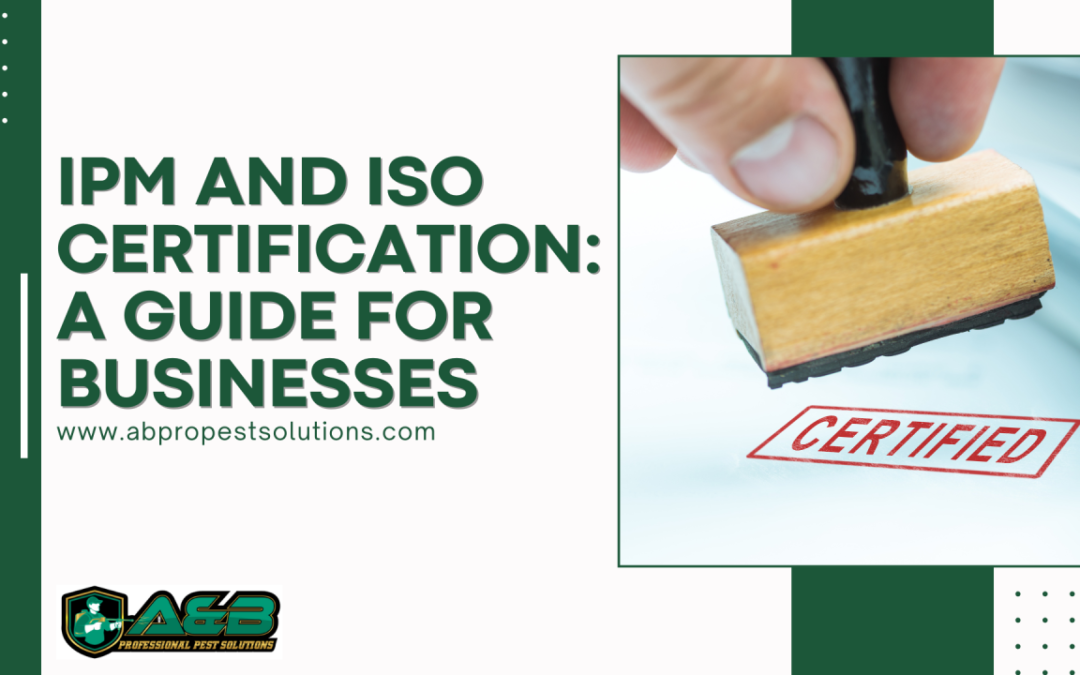In today’s competitive market, achieving ISO certification is a hallmark of quality and safety. Integrated Pest Management (IPM) is a crucial element for many ISO standards, particularly those related to health, safety, and environmental management. This guide explores the steps to integrate IPM for ISO certification and highlights the benefits it brings to various sectors, considering the latest market trends and innovations.
Steps to Integrate IPM for ISO Certification
- Understand the Requirements: Thoroughly understand the specific ISO standards your business aims to achieve, such as ISO 14001 (Environmental Management Systems) and ISO 22000 (Food Safety Management Systems). These standards emphasize sustainable practices, where IPM aligns perfectly by focusing on non-chemical pest control methods.
- Conduct a Pest Risk Assessment: Perform a comprehensive risk assessment to identify potential pest threats and vulnerabilities. This includes evaluating the facility’s layout, processes, and surrounding environment. Documenting these risks is essential for developing an effective IPM plan.
- Develop an IPM Plan: Create a tailored IPM plan based on the risk assessment. Include preventive measures, monitoring protocols, and control strategies. Ensure the plan covers all aspects of pest management, from sanitation and exclusion to biological controls and environmental modifications.
- Implement Preventive Measures: Focus on preventive measures to reduce pest infestations. This includes proper waste management, regular cleaning schedules, sealing entry points, and maintaining a clutter-free environment. These actions are fundamental in creating a pest-resistant facility.
- Establish Monitoring Protocols: Regular monitoring is key to early pest detection and effective management. Set up monitoring systems, such as traps and inspections, to track pest activity. Document and analyze the data to identify trends and adjust your IPM strategies accordingly.
- Train Employees: Educate and train employees on IPM practices and their roles in maintaining a pest-free environment. Continuous training ensures everyone is aligned with the IPM objectives, fostering a culture of vigilance and proactive management.
- Document and Review: Keep detailed records of all IPM activities, including risk assessments, monitoring results, and corrective actions. Regularly review and update the IPM plan to address new challenges and improve effectiveness. Documentation is crucial for ISO audits and demonstrating compliance.
- Conduct Internal Audits: Perform internal audits to evaluate the effectiveness of the IPM plan and its alignment with ISO standards. Identify areas for improvement and implement corrective actions. Internal audits prepare your business for the official ISO certification process.
Benefits of Integrating IPM for ISO Certification
- Enhanced Compliance and Safety: IPM helps businesses comply with ISO standards, enhancing overall safety and environmental management. This leads to a safer workplace, reduced risk of contamination, and improved public health outcomes.
- Improved Reputation and Credibility: Achieving ISO certification with a robust IPM plan demonstrates your commitment to quality and safety. This enhances your business’s reputation, credibility, and competitiveness in the market.
- Cost Savings: Effective IPM reduces reliance on chemical treatments, leading to cost savings on pesticides and potential health-related expenses. Preventing pest infestations also minimizes damage to products, equipment, and facilities, further reducing costs.
- Sustainable Practices: IPM promotes sustainable pest management practices that are environmentally friendly. This aligns with global sustainability goals and corporate social responsibility initiatives, appealing to eco-conscious consumers and stakeholders.
- Sector-Specific Benefits:
- Food Processing and Manufacturing: Ensuring a pest-free environment is critical for food safety and quality. IPM helps meet ISO 22000 requirements, preventing contamination and enhancing consumer trust.
- Healthcare Facilities: In hospitals and clinics, IPM supports ISO 14001 by maintaining a hygienic environment, reducing the risk of pest-borne diseases, and ensuring patient safety.
- Hospitality and Tourism: For hotels and resorts, IPM contributes to ISO 9001 (Quality Management Systems), enhancing guest experiences by maintaining clean and pest-free premises.
- Warehousing and Logistics: Effective pest management in warehouses ensures product integrity and compliance with ISO standards, protecting goods during storage and transit.
To know more about A&B’s services, please visit the A&B’s website (www.abpestsolutions.com.ph) or Facebook Page (https://www.facebook.com/ABPestSolutions/) to know more about their services. A&B also disinfects workplaces or houses to kill COVID-19 Virus.
You may also contact: +63 905 496 4550 and +63 951 062 4830
A&B Professional Pest Solutions Corporation is located at the Ground Floor of Monterey Building at Genesis St., Centro de San Lorenzo, Santa Rosa, 4026 Laguna, Philippines

